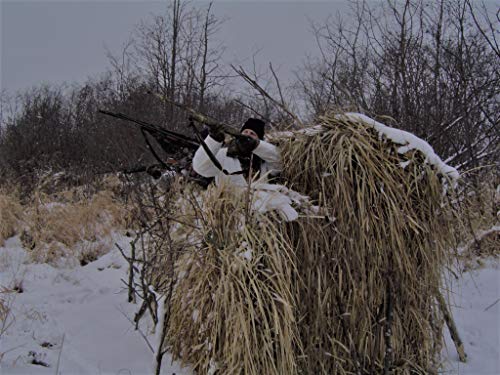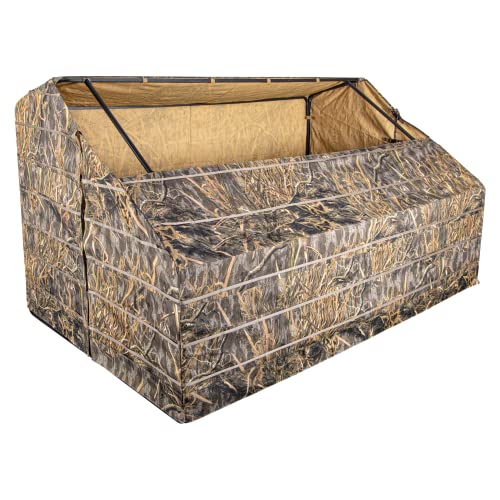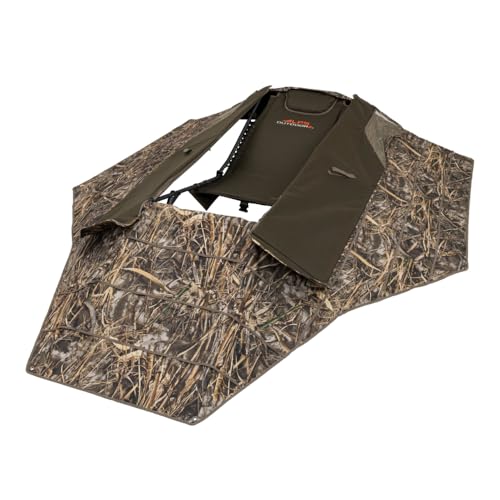↬ What direction should a duck blind face? This is a common question many hunters have with duck season approaching and the need to build new duck blinds. Knowing the right direction to set them up will be the key for success.
A duck blind should always be built facing the direction that the prevailing wind blows. This means a southwest direction if the wind blows from the northeast. You will have the wind at your back, and as we all know, ducks prefer to land into the wind. This will set you up for the best shots on ducks as they hover over the decoys.
However, there are many conditions where facing with the wind will not work and in this guide we’ll discuss tips and tactics on which directions duck blinds should face for variable wind conditions.
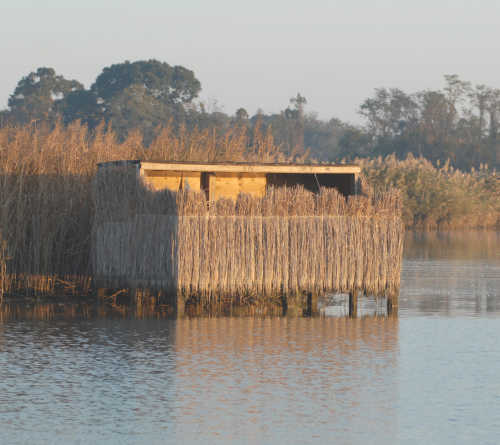
![]()
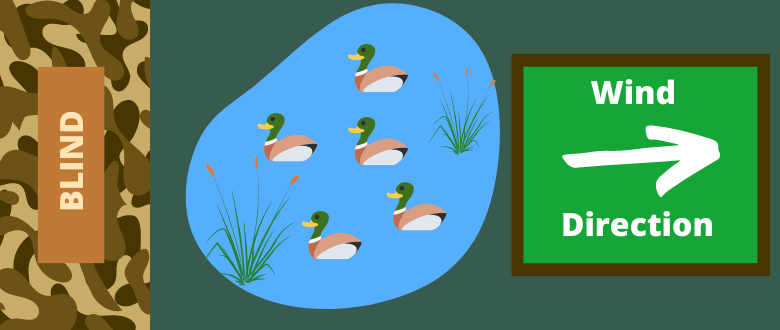
What direction should a duck blind face?
The effects of wind are the most important aspect to consider when determining which direction a duck blind should face. The general rule of duck blind placement 101 is to place the duck blind so that the prevailing wind is at your back.
When asked, WaterfowlChoke editors said “The sun also plays a large role in duck blind placement. You want to avoid placing a duck blind facing east so that the morning sun isn’t in your face. The sun not only makes it difficult to see incoming ducks, but it can shine off your face if you’re not wearing a face mask and cause birds to flare. It can also make movement in the blind easier to see.”
“Blind placement is straightforward when you have weather conditions that cooperate, but we all know that it rarely does when duck hunting. Underlying factors that prevent you from placing a duck blind where you want to include calm or foggy days, and these require a different approach.”
Continuing on, we’ll discuss the common problems that arise when determining which direction a duck blind should face.

Prevailing Winds
Winds while duck hunting can vary depending on location, day-to-day factors, and even from minute to minute. We’ve all been on a hunt where wind direction has changed during the hunt which required moving decoys and even the blind.
This constant attention to the wind can make it difficult to place a blind for all conditions. Below we discuss typical situations and which direction a duck blind should face to work the best.
Midwest. The prevailing wind in the Midwest during the winter is from the west. This means the ideal setup would be a blind facing east. To prevent the sun from shining in your face, place the blind in a northeast or southeast direction.
Gulf Coast. The gulf coast is a constant battle with wind direction as it changes frequently. During duck season, the prevailing winds are north and southeast. North winds are often short lived, so it’s better to place a blind facing north to hunt on a south wind. Facing the blind west can also work for hunting both wind directions.
Arkansas Timber. Timber hunting isn’t as reliant on wind direction as mallards typically drop straight down into the decoys. It’s more important to create shadows and placing a blind in a southwest direction will help prevent the sun from revealing it or the hunters inside.
River Hunting. Hunting small rivers, you should take into consideration that many birds tend to land with the current. Setting your blind in the direction of the flow will set you up for better shot opportunities.
Duck Blind Essentials
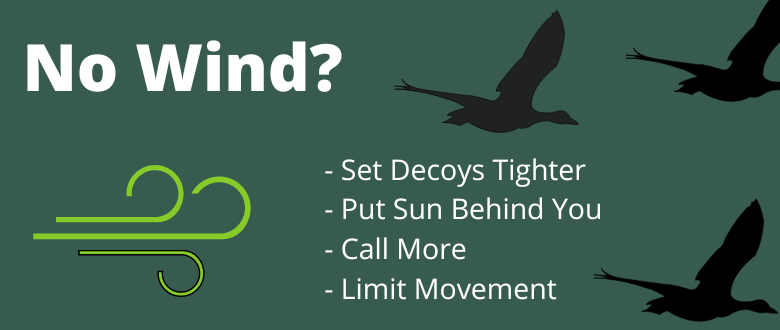
Blind Placement With No Wind
Calm days are the great equalizer when it comes to blind placement. There’s no rhyme or reason with choosing a direction on calm days based on wind. Other factors such as the sun and terrain avoidance should be the driving force behind blind placement instead.
WaterfowlChoke editors also added, “Fog can also be present on windless days. While it can hinder bird movement, if birds do show up, the action is close and quick. Placing a blind as close to the decoys as possible and keeping the decoy spread tight is the best technique while hunting in the fog.”
Blind Placement when the best spot doesn’t work
Duck hunting can be a sport of compromise and deciding which direction a blind should face is often guided by matters that are out of our control. These include property boundaries, terrain limitations, access issues, and direction firearms will be discharged.
If these factors prevent you from putting the wind at your back, it is not the end of the world. Ducks will still decoy, and you can have a good hunt, but you may just need to either taper expectations or become proficient with crosswind or going away shots.
Duck Blind Placement Tips:
- Avoid blinds facing east as the sun will be in your face
- West and Southwest directions will create shadows that aid in hiding
- A west facing blind can hunt both north and south winds
- Portable blinds allow you to switch direction if the wind changes
- Multiple blinds for different wind directions on the same water is always best
- Remove your blind on public land once the season is over
Variable Wind Directions
Nothing is more frustrating than the wind changing directions during a hunt. Whether it’s a front blowing through or a storm system moving in, wind changing from the south to north could mean your blind is facing the wrong direction.
Aside from checking the weather and being aware of changing conditions, the best ways to combat this are to either ditch the permanent blinds for portables, set multiple blinds that are ready for each wind direction, or bite the bullet and change the decoy spread.
The latter is always the most time consuming, but if the blind is permanent, you really don’t have a choice. Setting up multiple blinds for changing winds takes more effort but can pay off later in the season. Using layout blinds or other portable blinds are the least time consuming option and can be redeployed in minutes. The ALPS Outdoor Legend Layout Blind is one of the best at an affordable price.
SUMMARY
Portable blinds, such as layouts, are great for variable wind days. They allow you to quickly position the blind so that the wind is always at your back and in a favorable direction.
Coastal Marsh Blind Placement
Duck blinds in coastal marshes and public bays have their own set of challenges due to the competitive hunting that takes place and limited amount of space. Most bays and public waters that don’t have a blind system are first come first serve.
Just because a blind is built on public water, doesn’t mean the builder has reserved the spot. This is often a subject that can get heated as the blind builder has spent time and effort just to have someone else hunt the blind. When hunting public, remember that anything placed in the marsh the rest of the public can use and everything should be removed at the end of the season.
When determining which direction a blind should face in the marsh, the key aspects to consider are the vegetation height, shoreline direction, and duck flyways. Blinds should not be considerably higher than the native vegetation as they stick out like sore thumbs.
Blinds should match the color of the dormant vegetation behind it and be constructed parallel to the shoreline. Wind direction should also be considered, but often is of least priority due to the limited number of spots on public land.
Additionally, hiding in marsh grass without a blind or using 55-gallon drums cut in half to sit in can make you more versatile than others using large permanent blinds. This method will allow you to set up just about anywhere, be harder to spot by decoying ducks, and give you the edge come late season when ducks won’t approach fixed blinds.
Duck Blind FAQs
Where do you put duck blinds?
Duck blinds can be placed just about anywhere so long as there’s ample cover to blend in and you have permission to hunt the property. Blinds work well on banks of rivers, streams, ponds, and bays. In shallow water, duck blinds can be constructed in the water itself to get closer to where the birds want to land.
When constructing a duck blind, build the outer frame with 2×4 posts to the desired length, width, and height to make hunting out of it comfortable. Chicken wire can be stapled to the support posts that will allow you to secure camo netting or brush. A simple bench seat can be placed facing the water. Once complete, touch it up with natural vegetation growing nearby.
What wind direction is best for duck hunting?
The best wind direction for duck hunting is generally a south wind, but it can vary depending on other factors such as location, bird movements, and time of season. On the Gulf Coast, new birds tend to arrive with each cold front and a north wind can be good early.
South winds can be better as they pick up later in the season and birds move up from the coast to new areas they aren’t familiar with. Light to moderate winds are typically ideal as birds tend to trade back and forth more, rather than looking for cover to ride it out.
Which way do ducks land?
Ducks almost always land into the wind. The cupping of their wings creates drag, which reduces speed, and helps guide them to a landing spot. By landing with the wind, ducks can maximize the amount of drag and slow down faster.
Even though landing against the wind is the preferred method, it’s not always practical in real world situations. Tight landing areas or open water doesn’t always present itself with perfect landing opportunities. In these cases, ducks will land cross wind or even with the wind.
These scenarios aren’t typical, but they have been known to happen. Some ducks will come in fast with the wind at their back, and then do a tight turn into the wind just above the water for a controlled landing. These situations can make the ideal decoy placement and blind direction difficult to determine.
Do ducks fly with or against the wind?
Ducks can fly both with the wind and against it. However, ducks flying with the wind fly at a faster overall speed. Ducks flying against the wind fly faster (more wing beats per minute) to maintain a slower cruising speed.
The direction a duck chooses to fly is solely based on the location it is headed. Early migrators tend to fly with the wind as strong cold fronts push south out of Canada and into the U.S. Once ducks reach their wintering grounds, the direction they fly is guided more by food and water resources and hunting pressure.
Ducks will fly against the wind for shorter trips if they have a destination in mind, such as a flooded corn field. When flying against strong winds, ducks tend to hover, dip, and dive in the air as they make their way forward. This can give them ample time to spot hunters, predators, or situations they don’t like.
Bottom Line: Put the wind at your back
Duck blinds should always face the direction of the prevailing wind. The easy way to think about it is to always place the wind at your back. This ensures the ducks will land into the wind and provide you easy decoying shots.
Avoid placing a blind facing east since the morning sun will be in your face. Southeast or Northeast placement can offer some relief. Southwest is considered one of the best blind placement directions since the sun provides shadowing for those in the blind.
Using portable blinds, such as layouts, are the best options for days with variable wind. They can be rearranged in minutes compared to hunting out of a fixed blind where changing the decoy spread may take an hour. The ALPS Outdoor Legend Layout Blind is one of the best for this type of hunting.
Search Chokes by Gauge
Related Posts
- Best Waterfowl Choke Tubes for 2024, Expert Picks

- Choke Tube Diameter and Constriction Table

- 5 Easy Ways to Remove a Stuck Choke Tube

Last update on 2025-12-04 / Affiliate links / Product Images from Amazon Product Advertising API

